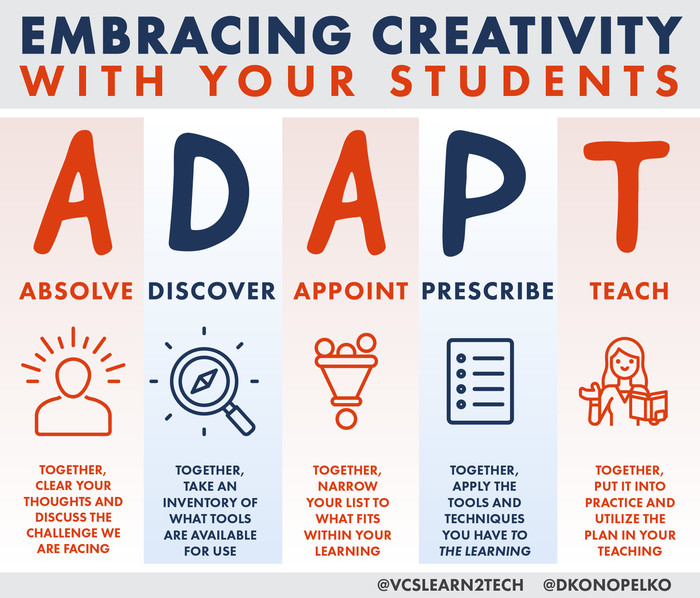Absolve: Acknowledge and Share the Stressors You’re Facing
Before identifying a path forward, clear your thoughts and acknowledge your current challenges. Rather than pressing on as if today were just another “normal” school day, it’s important to embrace the stressors you’re facing and discuss them openly with students and families.
Absolve yourself of the responsibility for actions and plans beyond your own, and chart a course forward toward success. If you’re a design-thinking enthusiast, this step is similar to the empathy or immersion phase.
Discover: Take Inventory of the Tools at Your Disposal
Think about the tools available and supported in your school or district, and create an inventory of what you can use. Do you have access to collaborative platforms such as Microsoft 365 or Google’s G Suite for Education? Have you tried Adobe Spark (which is free for all educators and students)? Or have you engaged English language learners and struggling students with an outside-the-box solution like Flipgrid?
This is your chance to collaborate with your colleagues and students, and brainstorm all that might be possible with the tools in your pedagogical quiver and digital toolbox. Remind yourself and your students to be innovative — almost anything is on the table, as this past spring’s creative graduation ceremonies showed.
READ MORE: Learn how immersive technology sparks student creativity.
Appoint: Find What Fits in Your Classroom
Individually and as a class, start to narrow your inventory to tools that fall within your zones of proximal development — the areas just beyond your comfort zone that you can reach with guidance or partnership. Take this opportunity to talk about and teach the art of curating ideas and content too.
Err on the side of keeping more tools than you throw away to create more room for student voice and choice. Make sure there are digital and analog choices available, as well as related creative uses and activities that will appeal to all learners. Don’t forget to check in with your IT or tech department to see whether the tools you’ve selected seamlessly integrate with your district’s learning management system. This will ease the burden of going back and forth when it comes to data collection and reporting — at its core, this is interoperability.
Prescribe: Apply the Tools and Techniques to Student Learning
Once you and your students have a good idea of the tools available to you and know which ones are within your skill set and comfort level, it’s time to apply that legwork to learning. This is when you take student voice and choice out of the hypothetical and see what happens when the rubber meets the road.
It’s also where you determine if any of the solutions you’ve created can transform old practices that still have some value but are starting to feel stale and typically lead to disengagement rather than a boost in curiosity. Reintroduce learning goals, objectives, scope and sequence, and other formal documentation for your courses. Chart the creative possibilities that may lend themselves well to different areas of student coursework.
In addition, consider joining professional learning communities on social media. In these groups, educators share relatable experiences which can act as catalysts for personal discoveries. With digital wishing wells such as Twitter, LinkedIn or Instagram, you can collaborate with other teachers to find new learning opportunities and gain ground-floor insight into their prescribed tools.
MORE ON EDTECH: Here's how one school district embeds creativity into everyday learning with technology.
Teach: Use the Tools in Your Practice
Remember that technology is just another tool in the toolbox. Both technological and traditional teaching methods will be valuable to the process of fostering creativity.
That said, provide opportunities for expression and model creativity for your students as you teach. Don’t just stop and smell the roses — paint them, build a collage with the petals and use the thorns as an inspiration for your next poem. Learn how to code the pattern the petals form using your favorite block editor. Take advantage of physical tools like a MakerBot and 3D print a copy of that rose, or dive back into informal ways of teaching, like exploring the great outdoors and dissecting those roses.
Overall, the ADAPT model can help you introduce creativity into your own practice. Find a way to work it into your instruction this year and create a safe space for your students to explore, question and embrace “novelty that works.”













